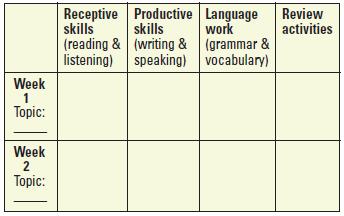Five things you always wanted to know about blended learning (but were afraid to ask)
In this series, Nicky Hockly explains aspects of technology which some people may be embarrassed to confess that they don’t really understand. In this article, she examines blended learning.
1. What exactly is blended learning?
The most common definition of blended learning is learning that combines face-to-face (f2f) teaching with online elements.
2. Why would I want to use blended learning?
As technology becomes increasingly ubiquitous, learners expect it to be integrated into their language classes. This means not only bringing technology into the classroom, but offering learners technologyenhanced options outside of class time. Learners today increasingly expect to be able to fit learning into their own busy lives and working schedules. This is particularly true of university students and adults who are busy professionals.
If you are a freelance teacher, offering a blended option to your learners may provide you with a unique selling point and an attractive degree of flexibility. In some situations, teachers are being asked by their institutions to offer blended options to learners. In other contexts, there may be Ministry of Education directives expecting teachers to offer blended learning in many disciplines.
So in some cases, teachers may want to start using blended learning, while in others they may have to start using it.


3. What’s the right blend?
There is no one right blend. The amount of f2f instruction versus online instruction can vary widely, and will depend on factors which include your teaching context, the needs and expectations of your learners, the resources you have available and the content and design of your course.
Let’s look at a number of possible blended learning scenarios:
- A business English teacher meets her learners for three hours a week. Because her learners are busy professionals, they cannot come to more than one hour per week of f2f class time. So she offers them an additional two hours per week of online work.
- An English for Academic Purposes teacher at a university teaches her B2- level students for one hour a day, Monday to Friday. The university has decided that at least 50 percent of all courses must be delivered online. So now she meets her learners for one hour on Monday and on Friday, and offers them three hours per week of online work.
- A language school in the UK offers intensive 25-hour-per-week summer courses to international students. After they leave the UK, they complete an additional ten hours of online work.
- A secondary school teacher meets her learners for three hours per week of f2f EFL classes. For homework, she regularly sets tasks using a range of Web 2.0 tools, such as creating online posters, mobile phone video or audio clips and posting to the class blog or wiki.
Scenario 4 is often where teachers start experimenting with blended learning, if they have a choice. The best way is to start small, preferably with one class and offering as little as ten percent of the work online – possibly simply as an extra, as in scenario 4 above. Once you and your learners gain confidence with the tools and online work, you can build more online components into your course.
4. I need to offer at least 50 percent of my course online. Where do I start?
Take a look at your syllabus. Identify those areas that are most easily delivered online, such as reading, writing and listening. Although speaking can also be delivered online (via group audio or video conferencing sessions, for example), you will want to keep as much speaking as possible for your f2f classes. You could use a blank grid in which to map out the main elements and activities of your course.
Then write in the following for each element:
- topic
- language focus
- whether this element will be offered online or f2f

- estimated time the activity will take
- interaction (individual, pair- or groupwork)
- if the activity is online, if it is synchronous (takes place in real time) or asynchronous (learners can contribute to the task when they like – within the task deadline)
It’s important to start with an overview of your course, and a clear awareness of which elements to offer online and which to offer in the f2f classroom. Mapping your coursebook syllabus for an entire month or term onto a grid can help you keep the big picture in mind.
5. How can I deliver the online part of my blended learning course?
Email is a ‘low-tech’ possibility. It could work in scenario 4, where the teacher could send homework instructions and links to online tools, or to the class blog or wiki, by email. But in a proper blended course, you would want to look at keeping your learners’ tasks and work in one place online, such as in a class wiki, a blog or in a virtual learning environment such as Moodle.
Whatever tool you decide to use, start small, try it out, get feedback and then adjust your task types and online delivery tools in the light of reflection and hindsight.
Nicky Hockly has been involved in EFL teaching and teacher training since 1987. She is Director of Pedagogy of The Consultants-E, an online training and development consultancy. She is co-author of Teaching Online (DELTA Publishing), which was nominated for a 2011 British Council ELTon award. She maintains a blog at www.emoderationskills.com.
This article first appeared in English Teaching professional, Issue 75, July 2011

Comments
Write a Comment
Comment Submitted